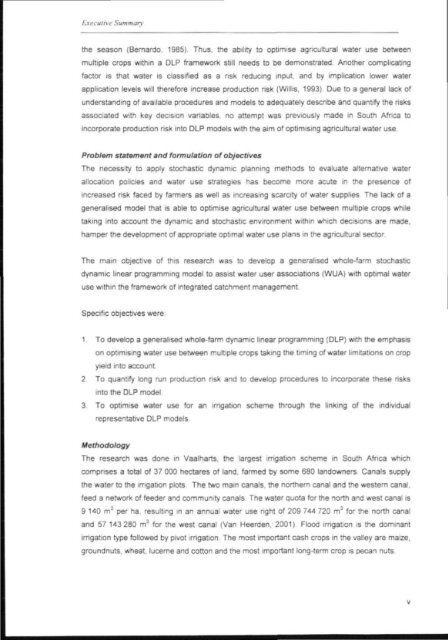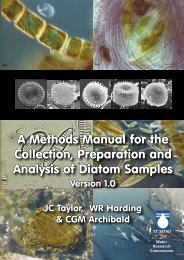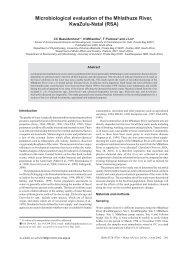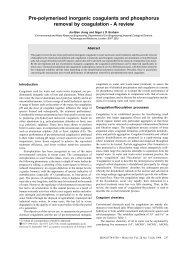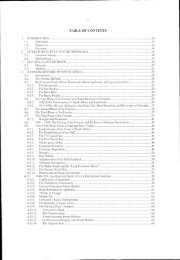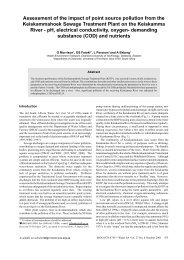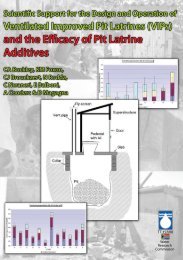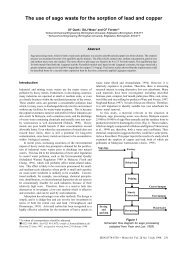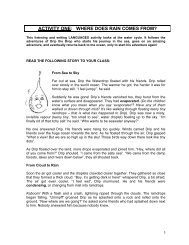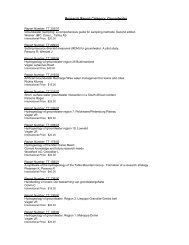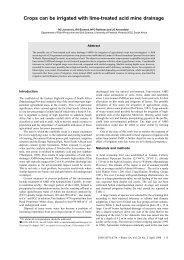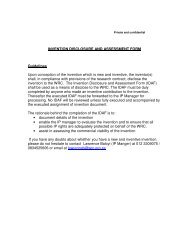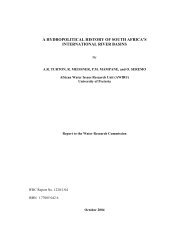GENERALISED WHOLE-FARM STOCHASTIC DYNAMIC ...
GENERALISED WHOLE-FARM STOCHASTIC DYNAMIC ...
GENERALISED WHOLE-FARM STOCHASTIC DYNAMIC ...
Create successful ePaper yourself
Turn your PDF publications into a flip-book with our unique Google optimized e-Paper software.
Executive Summar\-the season (Bernardo, 1985)- Thus, the ability to optimise agricultural water use betweenmultiple crops within a DLP framework still needs to be demonstrated. Another complicatingfactor is that water is classified as a risk reducing input, and by implication lower waterapplication levels will therefore increase production risk (Willis, 1993). Due to a general lack ofunderstanding of available procedures and models to adequately describe and quantify the risksassociated with key decision variables, no attempt was previously made in South Africa toincorporate production risk into DLP models with the aim of optimising agricultural water use.Problem statement and formulation of objectivesThe necessity to apply stochastic dynamic planning methods to evaluate alternative waterallocation policies and water use strategies has become more acute in the presence ofincreased risk faced by farmers as well as increasing scarcity of water supplies. The lack of ageneralised model that is able to optimise agricultural water use between multiple crops whiletaking into account the dynamic and stochastic environment within which decisions are made,hamper the development of appropriate optimal water use plans in the agricultural sector.The main objective of this research was to develop a generalised whole-farm stochasticdynamic linear programming model to assist water user associations (WUA) with optimal wateruse within the framework of integrated catchment managementSpecific objectives were:1. To develop a generalised whole-farm dynamic linear programming (DLP) with the emphasison optimising water use between multiple crops taking the timing of water limitations on cropyield into account.2 To quantify long run production risk and to develop procedures to incorporate these risksinto the DLP model.3 To optimise water use for an irrigation scheme through the linking of the individualrepresentative DLP models.MethodologyThe research was done in Vaalharts, the largest irrigation scheme in South Africa whichcomprises a total of 37 000 hectares of land, farmed by some 680 landowners. Canals supplythe water to the irrigation plots. The two main canals, the northern canal and the western canal.feed a network of feeder and community canals. The water quota for the north and west canal is9 140 m 3 per ha, resulting in an annual water use right of 209 744 720 m 3 for the north canaland 57 143 280 m 3 for the west canal {Van Heerden, 2001). Flood irrigation is the dominantirrigation type followed by pivot irrigation. The most important cash crops in the valley are maize,groundnuts, wheat, lucerne and cotton and the most important long-term crop is pecan nuts.


